Classifications Lute, String instrument | ||
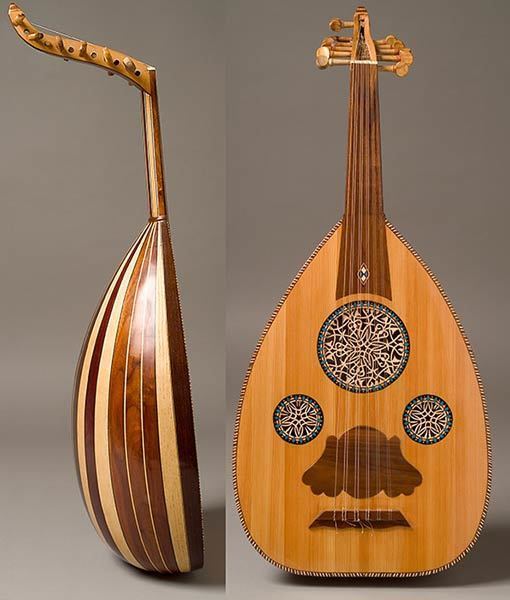 | ||
Instrument family String instrument, Plucked string instrument | ||
Turkish musical instrument oud
The oud ((/uːd/)) is a short-neck lute-type, pear-shaped stringed instrument (a chordophone in the Hornbostel-Sachs classification of instruments) with today 11 or 13 strings grouped in 5 or 6 courses, commonly used in Arabian, Greek, Turkish, Byzantine, Azerbaijani, Armenian, North African (Chaabi, Classical, and Spanish Andalusian), Somali and Middle Eastern music.
Contents
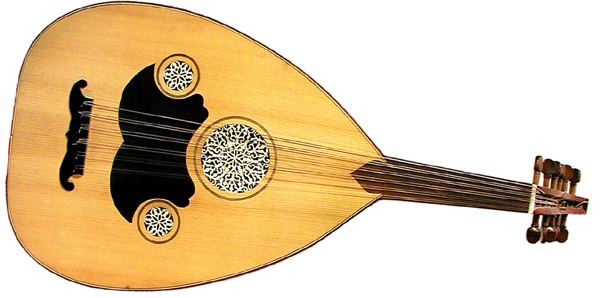
In the first centuries of Arabian civilisation, the oud had 4 courses (one string per course - double-strings came later) only, tuned in successive fourths. These were called (for the lowest in pitch) the Bamm, then came (higher to highest in pitch) the Mathnā, the Mathlath and the Zīr. A fifth string (highest in pitch, lowest in its positioning in relation to other strings), called ḥād ("sharp"), was sometimes added for theoretical purposes, generally to complement the double octave.

The Modern tuning preserves the ancient succession of fourths, with adjunctions (lowest or highest courses) which may be tuned differently following regional or personal preferences.
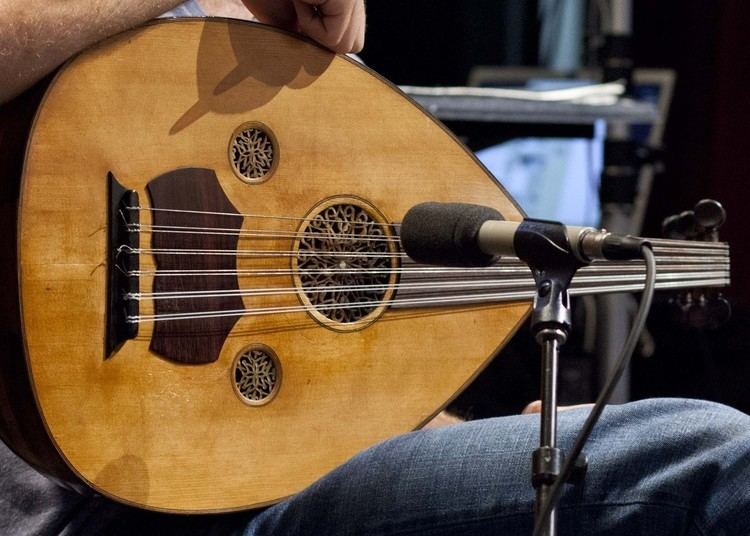
The first mention of an actual fifth string is by 11th-century musician, singer and author Abū-l-Ḥasan Muḥammad ibn al-Ḥasan ibn a-ṭ-Ṭaḥḥān in his compendium on music Ḥāwī al-Funūn wa Salwat al-Maḥzūn.

The first known complete description of the ‛ūd and its construction is found in the epistle Risāla fī-l-Luḥūn wa-n-Nagham by 9th-century Philosopher of the Arabs YaꜤqūb ibn Isḥāq al-Kindī. Kindī's description stands thus:
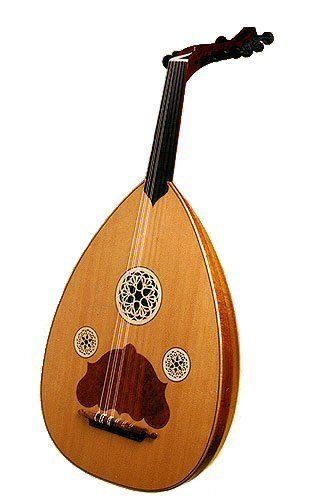
"[and the] length [of the ‛ūd] will be: thirty-six joint fingers - with good thick fingers - and the total will amount to three ashbār. And its width: fifteen fingers. And its depth seven and a half fingers. And the measurement of the width of the bridge with the remainder behind: six fingers. Remains the length of the strings: thirty fingers and on these strings take place the division and the partition, because it is the sounding [or "the speaking"] length. This is why the width must be [of] fifteen fingers as it is the half of this length. Similarly for the depth, seven fingers and a half and this is the half of the width and the quarter of the length [of the strings]. And the neck must be one third of the length [of the speaking strings] and it is: ten fingers. Remains the vibrating body: twenty fingers. And that the back (soundbox) be well rounded and its "thinning"(kharţ) [must be done] towards the neck, as if it had been a round body drawn with a compass which was cut in two in order to extract two ‛ūds".
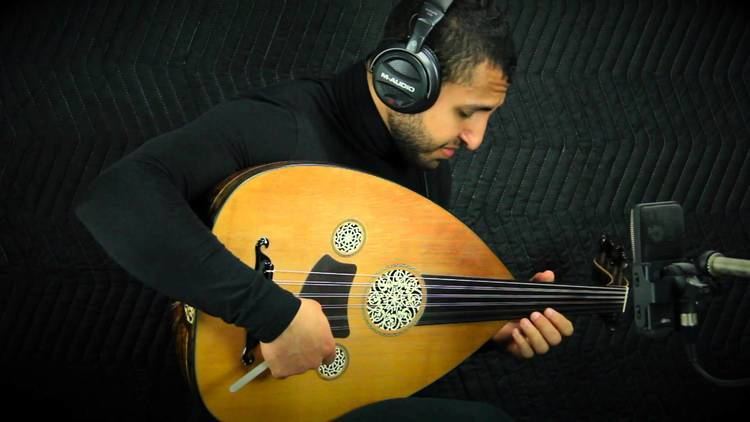
The first description of the "modern" oud is by ibn a-ṭ-Ṭaḥḥān. It is very similar to the construction of modern lutes, and to the construction of Western lutes. The modern oud stems most probably from the barbat which, in turn, stems from the Indian lute-type vīnā. The oud, as a fundamental difference with the western lute, has no frets and a smaller neck. It is the direct ancestor of the European lute. The oldest surviving oud is thought to be in Brussels, at the Museum of Musical Instruments.
The oud and luthier
Names and etymology
The Arabic: العود (al-ʿūd) literally denotes a thin piece of wood similar to the shape of a straw. It may refer to the wooden plectrum traditionally used for playing the oud, to the thin strips of wood used for the back, or to the wooden soundboard that distinguished it from similar instruments with skin-faced bodies. Henry George Farmer considers the similitude between al-ʿūd and al-ʿawda ("the return" – of bliss).
Research by Eckhard Neubauer suggests that oud may be an Arabic borrowing from the Persian word rōd or rūd, which meant string, stringed instrument, or lute.
Another researcher, archaeomusicologist Richard J. Dumbrill, suggests that rud came from the Sanskrit rudrī (रुद्री, meaning "string instrument") and transferred to Arabic through a Semitic language.
Names for the instrument in different languages include Arabic: عود ʿūd (Arabic pronunciation: [ʕu(ː)d, ʢuːd], plural: أعواد aʿwād), Armenian: ուդ, Syriac: ܥܘܕ ūd, Greek: ούτι oúti, Hebrew: עוּד ud, Persian: بربط barbat, Turkish: ud or ut, Azeri: ud, and Somali: cuud or kaban.
History
The modern Oud is a derived from the ancient Lute. The lute originates in the fertile crescent at least 5000 years ago, from which then moved to Egypt where we have painting of it dating back to 1350 B.C. The highly influential organologist Curt Sachs distinguished between the "long-necked lute" (Langhalslaute) and the short-necked variety: both referred to chordophones with a neck as distinguished from harps and psalteries. Smith and others argue the long-necked variety should not be called lute at all because it existed for at least a millennium before the appearance of the short-necked instrument that eventually evolved into what is now known as the lute. The long-necked variety also was never called a lutebefore the twentieth century.
Musicologist Richard Dumbrill today uses the word to discuss instruments that existed millennia before the term "lute" was coined. Dumbrill documented more than 3000 years of iconographic evidence for the lutes in Mesopotamia, in his book The Archaeomusicology of the Ancient Near East. According to Dumbrill, the lute family included instruments in Mesopotamia prior to 3000 BC. He points to a cylinder seal as evidence; dating from c. 3100 BC or earlier (now in the possession of the British Museum) the seal depicts on one side what is thought to be a woman playing a stick "lute". Like Sachs, Dumbrill saw length as distinguishing lutes, dividing the Mesopotamian lutes into a long variety and a short. His book does not cover the shorter instruments that became the European lute, beyond showing examples of shorter lutes in the ancient world. He focuses on the longer lutes of Mesopotamia, various types of necked chordophones that developed throughout ancient world: Greek, Egyptian (in the Middle Kingdom), Iranian (Elamite and others), Hittite, Roman, Bulgar, Turkic, Indian, Chinese, Armenian/Cilician cultures. He names among the long lutes, the pandura and the tanbur The line of short lutes was further developed to the east of Mesopotamia, in Bactria and Gandhara, into a short, almond-shaped lute.
According to Abū Ṭālib al-Mufaḍḍal (a-n-Naḥawī al-Lughawī) ibn Salma (9th century), who himself refers to Hishām ibn al-Kullā, the oud was invented by Lamech, the descendant of Adam and Cain. Another hypothetical attribution says that its inventor was Mani. Ibn a-ṭ-Ṭaḥḥān adds two possible mythical origins: the first involves the Devil, who would have lured the "People of David" into exchanging (at least part of) their instruments with the oud. He writes himself that this version is not credible. The second version attributes, as in many other cultures influenced by Greek philosophy, the invention of the oud to "Philosophers". However, there are no historical corroborations for any of these assertions.
The oldest pictorial record of a short-necked lute-type vīnā around the 1st to 3rd centuries AD. The site of origin of the oud seems to be India or Central Asia. The ancestor of the oud, the barbat was in use in pre-Islamic Persia. Since the Safavid period, and perhaps because of the name shift from barbat to oud, the instrument gradually lost favor with musicians. The Turkic peoples had a similar instrument called the kopuz. This instrument was thought to have magical powers and was brought to wars and used in military bands. This is noted in the Göktürk monument inscriptions. The military band was later used by other Turkic state's armies and later by Europeans. However, in both Turkey and Iran, as well as in Arabian countries, the main short-necked lute in use today is the oud. The oud has a particularly long tradition in Iraq, where a saying goes that in its music lies the country’s soul. It lies at the core of the music of Modern Egypt and other Arabian countries. A ninth-century Baghdad jurist praised the healing powers of the instrument, and the 19th-century writer Muhammad Shihab al-Din related that it "places the temperament in equilibrium" and "calms and revives hearts." Following the invasion of Iraq and the overthrow of the Ba'athist regime in 2003, however, the increasing fervor of Islamic militants who consider secular music to be haraam (sinful) forced many oud players and teachers into hiding or exile.
The ancestor of the oud, the barbat was in use in pre-Islamic Persia. Since the Safavid period, and perhaps because of the name shift from barbat to oud, the instrument gradually lost favor with musicians.
The Turkic peoples had a similar instrument called the kopuz. This instrument was thought to have magical powers and was brought to wars and used in military bands. This is noted in the Göktürk monument inscriptions. The military band was later used by other Turkic state's armies and later by Europeans.
However, in both Turkey and Iran, as well as in Arabian countries, the main short-necked lute in use today is the oud.
The oud has a particularly long tradition in Iraq, where a saying goes that in its music lies the country’s soul. It lies at the core of the music of Modern Egypt and other Arabian countries. A ninth-century Baghdad jurist praised the healing powers of the instrument, and the 19th-century writer Muhammad Shihab al-Din related that it "places the temperament in equilibrium" and "calms and revives hearts." Following the invasion of Iraq and the overthrow of the Ba'athist regime in 2003, however, the increasing fervor of Islamic militants who consider secular music to be haraam (sinful) forced many oud players and teachers into hiding or exile.
Types
Modern-day ouds fall into two categories: Arabian and Turkish. This distinction is not based solely on geography since Turkish ouds can also be found in Greece and occasionally other parts of the Mediterranean, whereas Arabian ouds can be found in various locations all over the Arab world. The Arabian ouds, such as the Iraqi oud, Egyptian oud and Syrian oud, are normally grouped under the term 'Arabian oud' because of their similarities, although local differences may occur, notably with the Iraki oud. However, all these categories are very recent, and do not do justice to the variety of ouds made in the 19th century, and also today.
Arabian ouds are normally larger than their Turkish counterpart, producing a fuller, deeper sound, whereas the sound of the Turkish oud is more taut and shrill, not least because the Turkish oud is usually (and partly) tuned one whole step higher than the Arabian. Turkish ouds tend to be more lightly constructed than Arabian with an unfinished sound board, lower string action and with string courses placed closer together. Arabian ouds have a scale length of between 61 cm and 62 cm in comparison to the 58.5 cm scale length for Turkish. There exists also a variety of electro-acoustic and electric ouds.
The Cümbüş is a Turkish instrument that started as a hybrid of the oud and the banjo.
